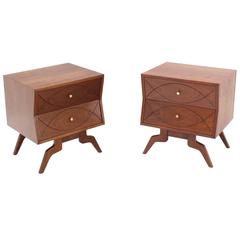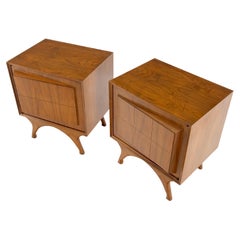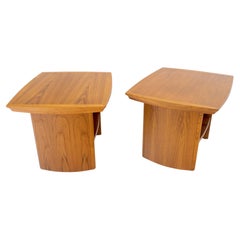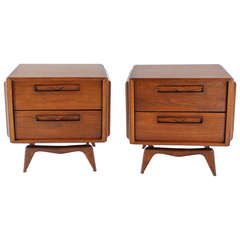Adrian Pearsall Nightstands
20th Century American Mid-Century Modern End Tables
20th Century American Mid-Century Modern End Tables
Walnut
20th Century Canadian Mid-Century Modern End Tables
Teak
Recent Sales
Mid-20th Century Unknown Mid-Century Modern Night Stands
Wood
20th Century American Mid-Century Modern Night Stands
20th Century American Mid-Century Modern End Tables
Walnut
20th Century American Mid-Century Modern Night Stands
Vintage 1950s American Mid-Century Modern End Tables
Walnut
Vintage 1960s American Mid-Century Modern End Tables
Wood, Walnut
20th Century American Mid-Century Modern End Tables
Walnut
20th Century American Mid-Century Modern End Tables
Walnut
People Also Browsed
1990s Italian Post-Modern Loveseats
Steel, Chrome
2010s British Scandinavian Modern Ottomans and Poufs
Sheepskin, Oak
2010s Italian Modern Chandeliers and Pendants
Metal, Brass
21st Century and Contemporary Italian Mid-Century Modern Wall Lights and...
Metal, Aluminum, Brass, Gold Leaf
2010s Italian Mid-Century Modern Table Lamps
Brass
20th Century American Mid-Century Modern End Tables
Walnut
Vintage 1970s Italian Mid-Century Modern Bookends
Marble
Mid-20th Century Japanese Mid-Century Modern Candlesticks
Iron
Vintage 1920s Dutch Art Deco Side Tables
Oak
2010s Swedish Scandinavian Modern Ottomans and Poufs
Sheepskin, Walnut
2010s American Mid-Century Modern Lounge Chairs
Velvet, Walnut
2010s Bosnian Mid-Century Modern Daybeds
Fabric, Beech, Velvet
Vintage 1960s Danish Mid-Century Modern Dressers
Teak
Vintage 1950s Danish Armchairs
Teak
20th Century American Art Deco Stools
Fabric
20th Century American Mid-Century Modern End Tables
Walnut
A Close Look at Mid-century Modern Furniture
Organically shaped, clean-lined and elegantly simple are three terms that well describe vintage mid-century modern furniture. The style, which emerged primarily in the years following World War II, is characterized by pieces that were conceived and made in an energetic, optimistic spirit by creators who believed that good design was an essential part of good living.
ORIGINS OF MID-CENTURY MODERN FURNITURE DESIGN
- Emerged during the mid-20th century
- Informed by European modernism, Bauhaus, International style, Scandinavian modernism and Frank Lloyd Wright’s architecture
- A heyday of innovation in postwar America
- Experimentation with new ideas, new materials and new forms flourished in Scandinavia, Italy, the former Czechoslovakia and elsewhere in Europe
CHARACTERISTICS OF MID-CENTURY MODERN FURNITURE DESIGN
- Simplicity, organic forms, clean lines
- A blend of neutral and bold Pop art colors
- Use of natural and man-made materials — alluring woods such as teak, rosewood and oak; steel, fiberglass and molded plywood
- Light-filled spaces with colorful upholstery
- Glass walls and an emphasis on the outdoors
- Promotion of functionality
MID-CENTURY MODERN FURNITURE DESIGNERS TO KNOW
- Charles and Ray Eames
- Eero Saarinen
- Milo Baughman
- Florence Knoll
- Harry Bertoia
- Isamu Noguchi
- George Nelson
- Danish modernists Hans Wegner and Arne Jacobsen, whose emphasis on natural materials and craftsmanship influenced American designers and vice versa
ICONIC MID-CENTURY MODERN FURNITURE DESIGNS
- Eames lounge chair
- Nelson daybed
- Florence Knoll sofa
- Egg chair
- Womb chair
- Noguchi coffee table
- Barcelona chair
VINTAGE MID-CENTURY MODERN FURNITURE ON 1STDIBS
The mid-century modern era saw leagues of postwar American architects and designers animated by new ideas and new technology. The lean, functionalist International-style architecture of Le Corbusier and Bauhaus eminences Ludwig Mies van der Rohe and Walter Gropius had been promoted in the United States during the 1930s by Philip Johnson and others. New building techniques, such as “post-and-beam” construction, allowed the International-style schemes to be realized on a small scale in open-plan houses with long walls of glass.
Materials developed for wartime use became available for domestic goods and were incorporated into mid-century modern furniture designs. Charles and Ray Eames and Eero Saarinen, who had experimented extensively with molded plywood, eagerly embraced fiberglass for pieces such as the La Chaise and the Womb chair, respectively.
Architect, writer and designer George Nelson created with his team shades for the Bubble lamp using a new translucent polymer skin and, as design director at Herman Miller, recruited the Eameses, Alexander Girard and others for projects at the legendary Michigan furniture manufacturer.
Harry Bertoia and Isamu Noguchi devised chairs and tables built of wire mesh and wire struts. Materials were repurposed too: The Danish-born designer Jens Risom created a line of chairs using surplus parachute straps for webbed seats and backrests.
The Risom lounge chair was among the first pieces of furniture commissioned and produced by celebrated manufacturer Knoll, a chief influencer in the rise of modern design in the United States, thanks to the work of Florence Knoll, the pioneering architect and designer who made the firm a leader in its field. The seating that Knoll created for office spaces — as well as pieces designed by Florence initially for commercial clients — soon became desirable for the home.
As the demand for casual, uncluttered furnishings grew, more mid-century furniture designers caught the spirit.
Classically oriented creators such as Edward Wormley, house designer for Dunbar Inc., offered such pieces as the sinuous Listen to Me chaise; the British expatriate T.H. Robsjohn-Gibbings switched gears, creating items such as the tiered, biomorphic Mesa table. There were Young Turks such as Paul McCobb, who designed holistic groups of sleek, blond wood furniture, and Milo Baughman, who espoused a West Coast aesthetic in minimalist teak dining tables and lushly upholstered chairs and sofas with angular steel frames.
Generations turn over, and mid-century modern remains arguably the most popular style going. As the collection of vintage mid-century modern chairs, dressers, coffee tables and other furniture for the living room, dining room, bedroom and elsewhere on 1stDibs demonstrates, this period saw one of the most delightful and dramatic flowerings of creativity in design history.
Finding the Right End-tables for You
Beyond just providing additional tabletop space for your living room, an attractive vintage end table can help you organize as well as display books and decorative objects.
The term “end table” is frequently used interchangeably with “coffee table,” and while these two furnishings have much in common, each offers their own distinctive benefits in your space.
Your end table is likely going to stand as tall as the arms of your sofa, and its depth will match the seating. These attributes allow for tucking the table neatly at the end of your sofa in order to provide an elevated surface between your seating and the wall. End tables are accent pieces — they’re a close cousin to side tables, but side tables, not unlike the show-stealing low-profile coffee table, are intended to be positioned prominently and have more to do with the flow and design of a room than an end table, which does a great job but does it out of the way of everything else.
End tables with a drawer or a shelf can easily stow away books or television remotes. Living-room end tables frequently assist with lighting, specifically as they’re often positioned adjacent to a wall. Their height and compact tabletop render them ideal for table lamps and plants, particularly if parked near a window.
And given their practicality, there is no shortage of simple, streamlined end tables from mid-century modern favorites such as Baker Furniture Company, Dunbar and Knoll that will serve your clutter-clearing minimalist efforts or wide-open loft space well. But over the years, furniture designers have taken to venturesome experimentation, crafting tables from fallen trees, introducing organic shapes and playing with sculptural forms, so much so that your understated end table might eventually become the centerpiece of a room, no matter where you choose to place it. One-of-a-kind contemporary designs prove that there are endless options for what an end table can be, while furniture makers working in the Art Deco style have proven that end tables can be stacked, staggered and nested at will, creating all kinds of variations on this popular home accent.
Find an extraordinary variety of antique, new and vintage end tables on 1stDibs today.
- 1stDibs ExpertMarch 22, 2022One way to identify an Adrian Pearsall is to consider the materials used. A genuine Adrian Pearsall will feature real wood, glass and metal, while imitations often use cheaper materials like composites and plastics. Pearsall didn't sign his work, so items that show his signature are unlikely to be authentic. On 1stDibs, find a selection of expertly vetted Adrian Pearsall furniture.
- 1stDibs ExpertMarch 22, 2022To pronounce Adrian Pearsall, say "A-dree-an PEER-sall." Pearsall was an American architect and furniture designer. He was born on September 18, 1925, in Trumansburg, New York, and he died on September 6, 2011, in Upper Makefield Township, Pennsylvania. You'll find a collection of Adrian Pearsall furniture on 1stDibs.
- 1stDibs ExpertMarch 22, 2024Yes, Adrian Pearsall designed lamps. Most of his lighting designs were floor lamps produced by the manufacturer Modeline during the 1960s. Many have not survived the years.
Pearsall is a revered mid-century modern designer. He gave his imagination free rein, and his flamboyant, eye-catching styles are icons of what has become known as “Atomic Age” design.
Find vintage mid-century modern lighting on 1stDibs. - 1stDibs ExpertMarch 22, 2022Most Adrian Pearsall furniture was handmade. Although wood composites and plastics gained popularity during the period, Pearsall preferred to build his pieces from genuine wood, glass and metal. Walnut wood was one of his most commonly used materials. Shop a range of Adrian Pearsall furniture on 1stDibs.
- 1stDibs ExpertMarch 22, 2022To begin to authenticate an Adrian Pearsall table, closely examine the materials. Authentic pieces will contain no plastics or composite woods, as Pearsall only worked with genuine wood, metal and glass. Also, you won't find a signature or mark on a real Adrian Pearsall table. On 1stDibs, find a collection of expertly vetted Adrian Pearsall tables.
- 1stDibs ExpertMarch 22, 2022No, Adrian Pearsall did not usually sign his work. One way to identify his work is to examine the materials. Pearsall only used genuine wood, glass and metal. Pieces that feature wood composites or plastics aren't genuine. His pieces reflect characteristics of the atomic style, often flaunting smooth lines, graceful curves and asymmetrical details. On 1stDibs, find a variety of expertly vetted Adrian Pearsall furniture.
- 1stDibs ExpertMarch 22, 2022Yes, Adrian Pearsall did work for Bassett, designing tables and seating. He also manufactured his own designs through his company Craft Associates. He founded his workshop in 1952 in Pennsylvania. The company exists today but no longer has an affiliation with Pearsall. Find a selection of Adrian Pearsall on 1stDibs.
- 1stDibs ExpertMarch 22, 2022To authenticate an Adrian Pearsall sofa, focus on the frame. A genuine Pearsall piece will have a solid wood frame because the designer never used wood composites. Original upholstery tends to show off bright, solid colors. However, many authentic Adrian Pearsall sofas come reupholstered. On 1stDibs, shop a collection of expertly vetted Adrian Pearsall sofas.
- 1stDibs ExpertMarch 22, 2022Like other designers working in the atomic style, Adrian Pearsall typically used fabric upholstery. Generally, the upholstery was a bright color, and solids were more common than patterns. Often, Adrian Pearsall sofas and chairs being sold today do not feature original upholstery because the fabric tends to wear out before the frame. You'll find a selection of Adrian Pearsall furniture on 1stDibs.
Read More
The Ultimate Guide to Types of Tables for the Home
Whether you’re just moving in or ready to give your home a makeover, our guide will give you pointers on tables that are fitting for every room, nook and hallway.
May’s Most Popular Interiors on Instagram
Our feed is filled with the world's most beautiful spaces. See the rooms our followers have deemed the best of the best this month.
New Orleans’ Lee Ledbetter Makes Design Magic by Mixing Past and Present
The Louisiana-born and -bred architect talks to 1stdibs about the art of making timeless places that matter.
Desert Modern Designer Arthur Elrod Finally Gets His Day in the Sun
The Palm Springs interior decorator developed a mid-century style that defined the vacation homes of celebrities and other notables, including Bob Hope and Lucille Ball.
From the Hamptons to Palm Springs, FormArch’s Homes Embody Both Comfort and Cool
The houses from this New York studio cloak modernist tendencies within what are often more traditional trappings.




